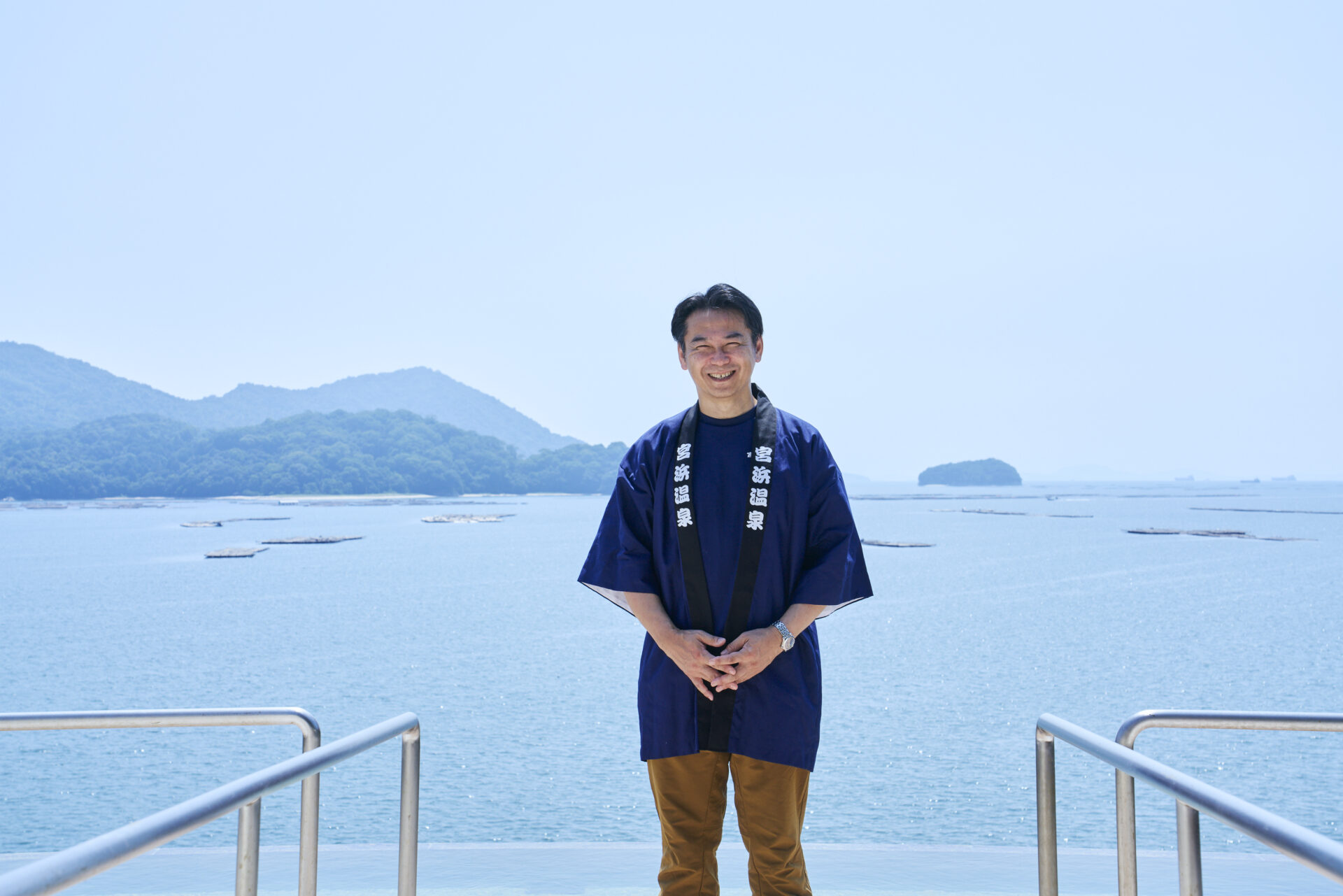
Connecting the Sea, Mountains, and Town of Setouchi: The Challenge of Miyahama Onsen—Building a Shared Future for the Entire Community

檜谷 直史
Naofumi Hitani
Hatsukaichi [Hiroshima]
Born in Hatsukaichi City, Hiroshima Prefecture. Third-generation proprietor of Yunoyado Miyahama Grand Hotel. After moving to Tokyo for university, he worked for eight years at a major travel company. Returning home in 1999, he joined the family business founded by his grandfather and later assumed leadership. Alongside revitalizing the inn, he has actively worked on community development—launching the Miyahama Onsen Festival in 2001 and Miyahama Adventures in 2019, a hands-on tourism initiative that explores the unique potential of the region.
Facing the Seto Inland Sea, Yunoyado Miyahama Grand Hotel stands as a symbol of Miyahama Onsen. Its third-generation owner, Naofumi Hitani, has long believed in the potential of his community while revitalizing the long-established inn and envisioning the future. From launching the Miyahama Onsen Festival to creating the hands-on tourism project Miyahama Adventures, his efforts have always been rooted in one conviction: to pass on an onsen town that future generations can be proud of. We spoke with Mr. Hitani about his journey so far and the vision that drives him forward.
A Third-Generation Owner’s Challenge: Revitalizing Both the Inn and Miyahama Onsen
Perched along the coastline of Miyahama Onsen, Yunoyado Miyahama Grand Hotel offers a sweeping view of the islands scattered across the Seto Inland Sea and the World Heritage Site of Miyajima from its open-air rooftop bath. Steering this historic inn is Naofumi Hitani, a native of the area. After eight years working for a travel agency in Tokyo, he returned home in 1999 to take over the family business.
His grandfather had founded the inn in 1965—the very year Miyahama Onsen first opened. Originally named Miyahamaso, the hot spring resort was established in the former Ōno Town as part of postwar reconstruction efforts.
“This region has long been cherished as a retreat, blessed with beautiful scenery, fresh air, and natural spring water. But in 1945, soon after the atomic bombing, Typhoon Makurazaki devastated the coastal areas. To rebuild the ruined town, the then-mayor of Ōno launched a plan to revive it as a hot spring resort. Once hot spring components were found in the local spring water, development began in earnest.”
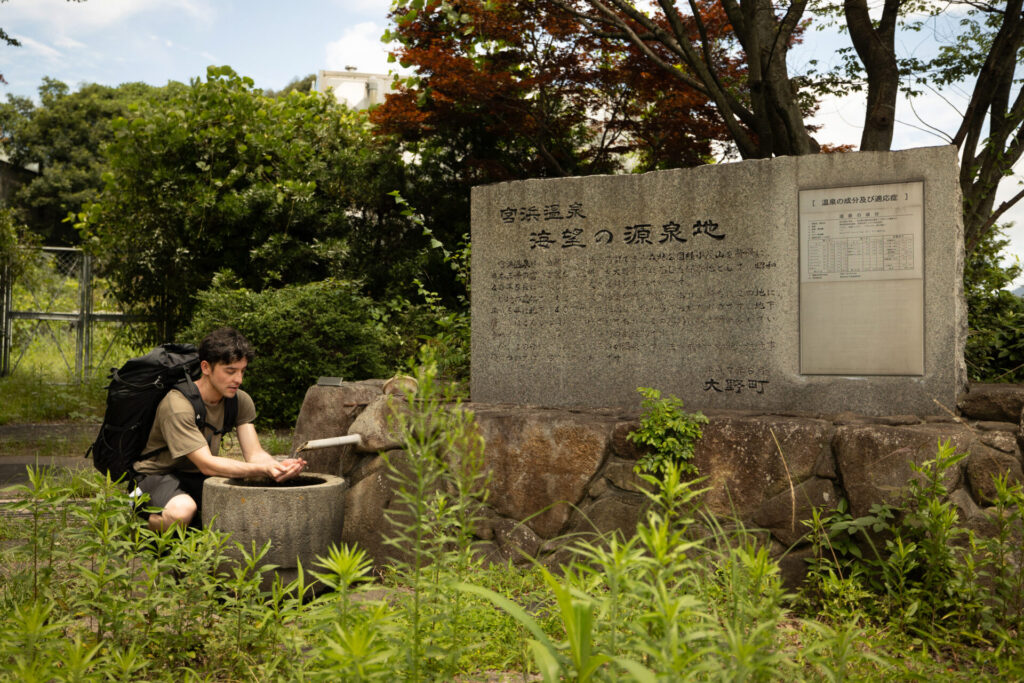
Known as a bijin no yu—a “beautifying bath”—Miyahama Onsen’s mildly alkaline water is said to smooth the skin and help relieve neuralgia, muscle pain, and women’s ailments. Thanks to its proximity to the tourist hub of Miyajima, the area flourished soon after opening. When NHK aired the historical drama The Tale of the Heike in 1972, set on Miyajima, visitors flooded in and the town bustled.
However, the subsequent oil crisis and later the bursting of Japan’s economic bubble took their toll. By the time Hitani returned, the facilities had aged, and visitor numbers were in decline.
“Having seen inns across Japan during my travel agency days, I was struck by the difference. The number of inns here had dwindled from over a dozen to just six. I knew we had to act quickly. In my first few years, I focused on refurbishing the facilities and creating unique accommodation plans to attract guests—this was before online booking sites were common, so we really had to push hard.”
Around that time, a childhood friend and senior member of the local onsen association approached him: “Let’s do something to revitalize the community together.” That invitation marked the beginning of the Miyahama Onsen Festival.
From a Festival to a Vision for the Future—and Rediscovering the Inn’s Strengths
While tackling the challenges facing his inn, Hitani also found new purpose through community collaboration. In 2001, the local Chamber of Commerce youth group launched the Miyahama Onsen Festival, with Hitani among the organizers.
Initially held on weekdays with sparse attendance, the festival gained momentum after moving to the last Sunday of August. It grew into a beloved annual summer event that brought energy back to the onsen town.
One of its biggest hits was the Pillow Fight World Championship at an Onsen Inn.Originally started by young hot spring inn owners across Japan to boost their regions, the event rotated from Arima and Yubara to Miyahama, where it became a signature attraction.
“Inspired by the idea that ‘onsen means pillow fights,’ participants compete to see who can throw a pillow the farthest—like a hammer-throw event. Its simplicity made it a success, and last year, we had 240 participants. What began as an experiment is now firmly rooted as our local festival.”
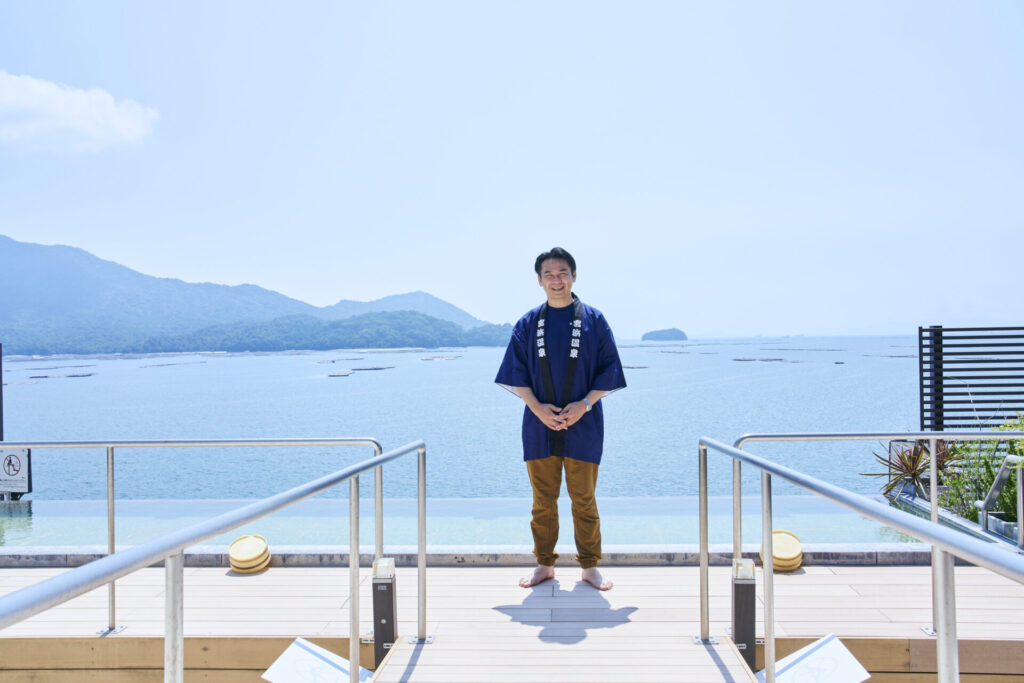
At the same time, Hitani was transforming his hotel. Leveraging its prime location—close to Miyajima and with easy access to central Hiroshima and Iwakuni’s Kintaikyo Bridge—he revamped facilities multiple times, including a major renovation of the open-air bath in 2017. The stunning sea view became a major draw for both overnight and day guests.
“There are countless hot springs across Japan, and we can’t compete on water quality alone. Guests choose Miyahama Onsen and our inn because of this view.”
The combination of community connection through the festival and renewed confidence from revitalizing the inn inspired Hitani to think beyond—toward a new kind of tourism that would encompass all of Miyahama. This vision became Miyahama Adventures.
Showcasing Miyahama’s Natural Wonders: “Miyahama Adventures”
After two decades back home, Hitani wanted to attract even more visitors to the area. In 2019, he launched Miyahama Adventures, an experiential tourism project spanning the entire onsen district. The members include not only onsen operators but also local businesses based on the nearby sea.
The project’s two main pillars are “the sea” and “the mountains.”
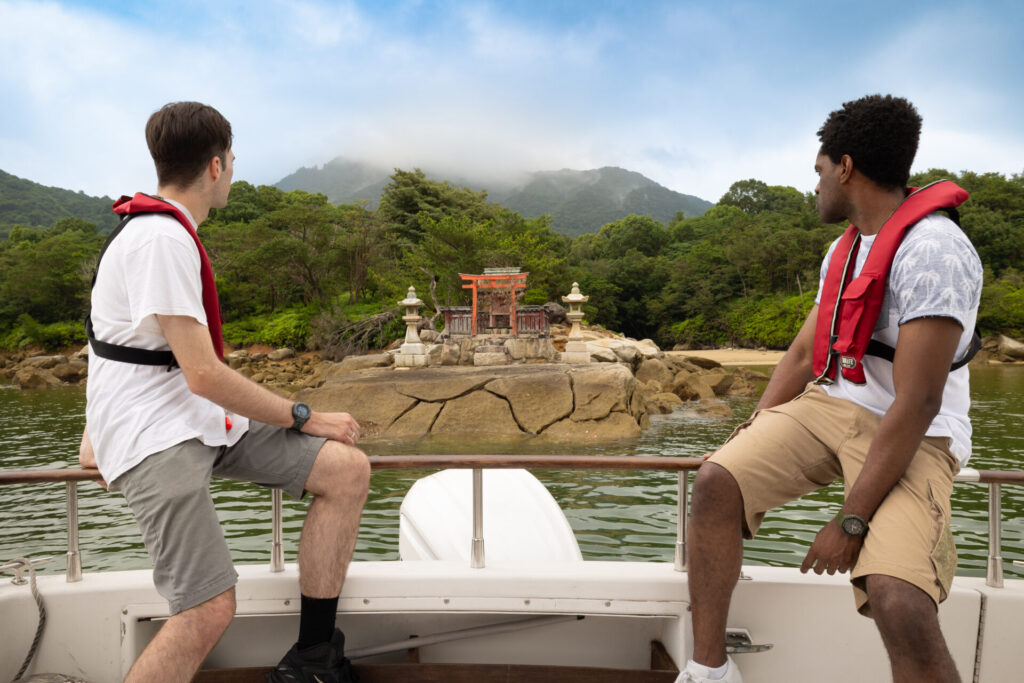
Activities include yacht sailing and sea kayaking, as well as a lunch cruise on the raft-shaped boat HANAIKADA, where guests can savor dishes made from local ingredients. The Miyajima West Coast Cruise, another highlight, takes visitors by small cruiser to worship at Mitoko Shrine and Suyaura Shrine on Miyajima’s western shore—mirroring part of the traditional Nanaura Meguri purification ritual once performed before visiting Itsukushima Shrine.
The experience attracts both domestic and international travelers, as well as local participants.
“Our first mission was to repair a privately owned pier and turn it into a gateway for marine tourism. By connecting with operators already running sea-based activities, collaboration began to take shape.”
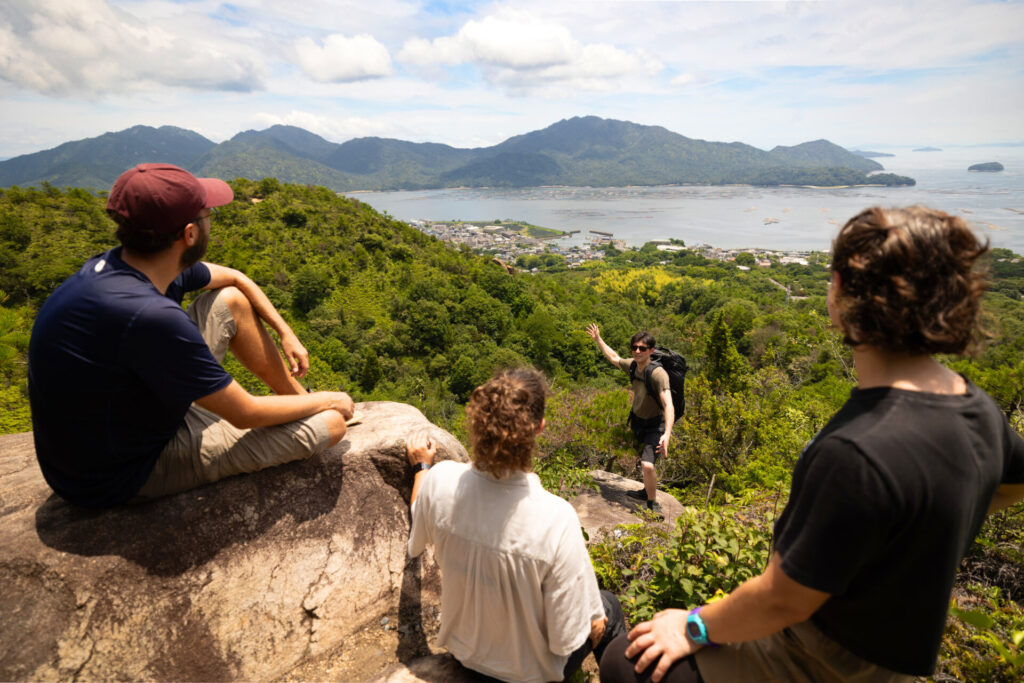
The second pillar is Mt. Kegoya. The popular Half-Day Trekking Tour takes visitors up to the mountain’s midsection (596m peak), guided by locals including Hitani himself. Along the roughly three-hour round trip, trekkers visit small shrines and a natural hot spring source, while learning about the area’s history and legends.
At the 270m viewpoint, a breathtaking panorama of the Seto Inland Sea and Miyajima unfolds before them.
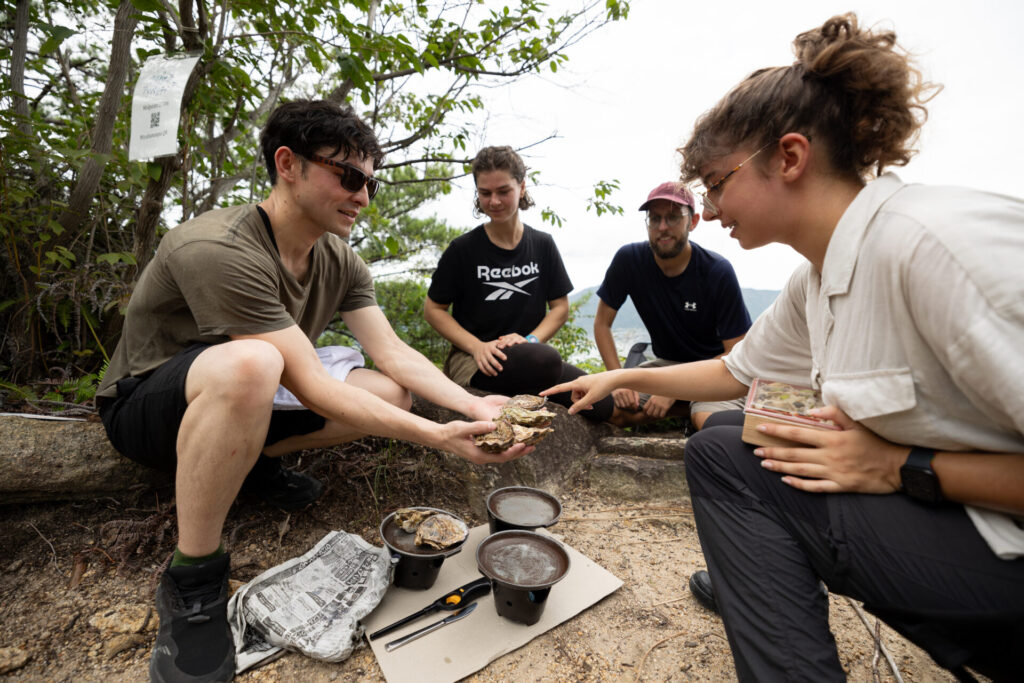
There, participants are treated to a handmade bento from Yunoya Wataya and freshly harvested oysters from Miyahama’s coast—grilled on-site. Many describe it as a one-of-a-kind experience where the sea’s bounty meets the mountain’s serenity.
“Enjoying a meal with that view—it’s simply the best!” one participant shared.
After descending, guests visit the Japanese garden of Sekitei, ranked the fourth most beautiful in the world, to enjoy tea and sweets. More than a hike, the tour weaves together walking, learning, dining, and healing—creating a complete story.
It concludes with guides sharing the history of Miyahama Onsen’s birth—how the resort emerged from postwar devastation as a symbol of recovery.
“I want people to understand that every historical event shaped the roots of Miyahama Onsen. After the atomic bombing destroyed Hiroshima’s weather observatory, there was no way to predict the typhoon that devastated this area. If that tragedy hadn’t occurred, the disaster might have been prevented. Through this story, I hope participants feel both the resilience behind Miyahama’s rebirth and the importance of peace.”
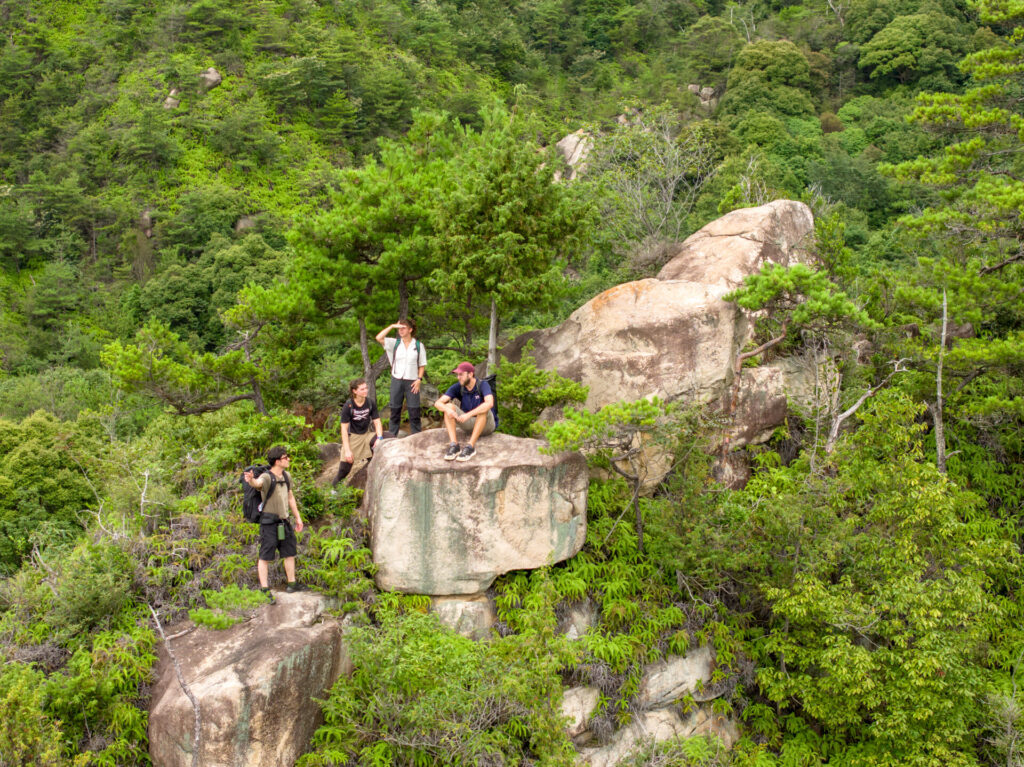
The Half-Day Trekking Tour received the MVP Award at the HYPP AWARD 2024 organized by the Hiroshima Tourism Federation, drawing attention from across and beyond the prefecture. Its recognition underscores Miyahama Adventures as a new model for connecting the sea, mountains, and community of Setouchi.
Carrying the Future Forward
When asked what he hopes to pass on to future generations, Hitani reflects deeply.
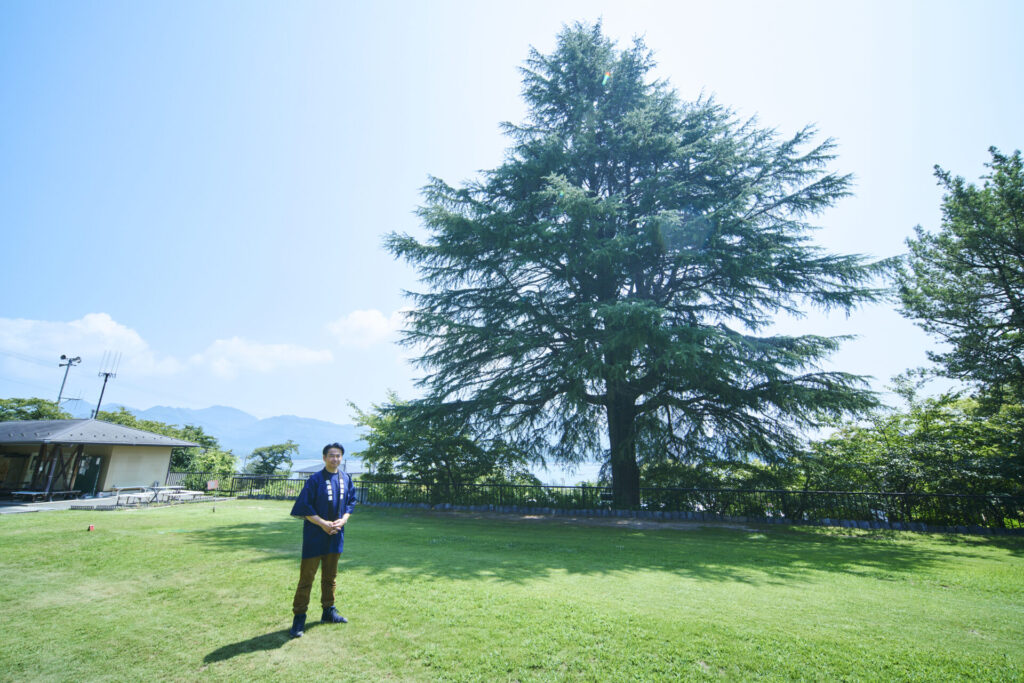
“It’s been 60 years since Miyahama Onsen opened. In 2018, our onsen association created a 100-Year Vision—dividing the area into three zones: the Seaside Area, the Walking Area in the mountains, and the Spa Area with the inns. We discussed what each should look like moving forward. There are still 40 years until the centennial, and my role is just a small dot in that timeline.
But even so, I want to hand this town to the next generation in the best shape possible. That’s the purpose behind both the festival and Miyahama Adventures.”
Plans are also underway to develop a walking route around the third hot spring source, centered on a symbolic Himalayan cedar tree. The vision includes footbaths, cafés, and spaces where visitors can enjoy views of both the sea and mountains—a place where people naturally gather, day and night.
For Hitani, Miyahama is more than home—it’s where his heart rests. Leaving during his student days only deepened his affection. That’s why he continues to uncover its potential, together with his local peers, for the sake of those who will come next.
“What matters most is showing that I myself am enjoying this town. That’s what inspires others.”
In his words shines a profound love for Miyahama Onsen—the place he calls home.
